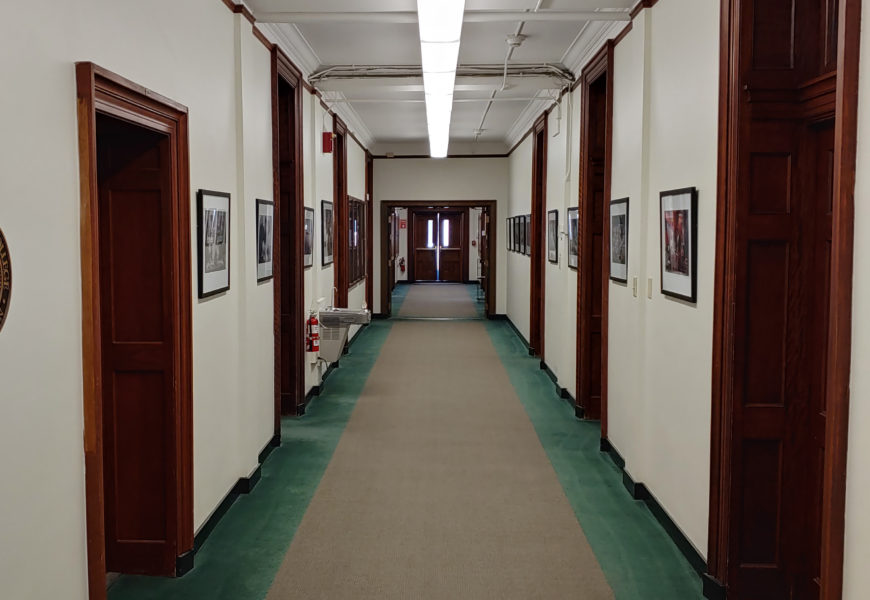Photo courtesy of Sophia Angele-Kuehn.
I decided to come to Connecticut College because of the bathrooms in Fanning. It was Open House on a brilliant October morning in 2015. Throughout the day, I shared a delicious lunch with the English Department in the 1962 room, attended a Latin Poetry class with my family, and ate a chocolate muffin in Blue Camel Cafe. However, it was at the quietest point of the day, after the poetry class had ended and my family and I were wandering the deserted halls of Fanning, that I finally envisioned myself as a student here. I wanted to walk these same halls, go up all three flights of stairs with a backpack full of books and a takeaway latte, passing the delicate windows set high above, hearing the echo of my shuffling steps.
Everyone has some story prepared in the back of their mind with why they chose to come here. Maybe you have had a Camel sweatshirt since birth or blue is your favorite color. What struck me most of all about Connecticut College was its “aura,” its promise of a blackboard seminar learning experience and an afternoon spent reading in a striped chair at Blue Camel cafe; that is, its “image,” a vision of the future.
My family and I finally got ready to leave and took a bathroom break. When we reconvened again, my mom, an occasional HGTV viewer, commented on the black and white tile in our bathroom. My dad was standing by the stairs, quietly adjusting his jacket over his arm: “Oh, yeah! Mine had a full-length mirror, even a chair for me to put down my coat!” It was this simple, passing remark on a design detail of a seemingly neglected building that kindled a special kind of bond between Connecticut College’s architecture and me.
A couple months ago, I heard a rumor that the first floor of Fanning would begin its renovation into the Office of Career and Professional Development during spring break. “All glass and white,” my source said. “A lot of light.” After I heard this, I whispered “Oh no…” and put my chin on my hand. My chest hurt a little as I went back in time. I decided I had to go back one last time before break and walk down its halls, and maybe take some pictures. I was soon standing in front of three pastel-bright architectural renderings behind glass.
I was taken aback, and a little disturbed by the figures that resembled the dotted backgrounds in comic books. My home was rendered in 2D, the trees transparent. “No,” I said again, scanning the pages. I had trouble even seeing my campus, which had dramatically turned into a small university. I got mad. I wanted to protest. I was almost driven to low-key vandalism by wanting to take out a Post-It note and slap it over the too-cheerful plans, also probably scrawled with a resolute “No!” I didn’t want a “connector” building between Fanning and Bill Hall, ruining the symmetry of every building surrounding Tempel Green. I didn’t want an outdoor amphitheater, taken right from Swarthmore College, between Cro and the Plex, rendering the tent set-up of Floralia impossible.
However, the “Master Plan” is already starting to take place. The renovation and career office take-over in Fanning will actually begin in a few weeks time. Last April, President Bergeron emailed “Exciting News! Building for the Future” to everyone about the $20 million in donations to go toward Palmer auditorium renovations. Palmer’s renovations will be completed in the Fall of 2021, according to the “Campus Master Plan” webpage on the College website. And before even I set foot on campus for the first time, former College President Leo Higdon and his administration were wrapping up their “Campaign for Connecticut College” with the completion of a road from Tansill Theater to Winthrop Hall in 2016. The renovations in New London Hall and Shain library had already been completed in 2012 and 2015, respectively. The sparkling, sunny renovation of the library was even one of the contributing factors in my decision to come to Conn rather than another NESCAC; prior to the renovation, the library was also originally designed in the hulking Brutalist architecture of the 70s. So why did I have such a strong reaction against these colorful sketches of the future of the College?
Perhaps this reluctance of change stems from the fact that everytime I walk from the Plex to my Blackstone dorm, or from Shain to Cummings, I’m witnessing history right before my eyes. The Georgian symmetry of Blaustein lies besides the Collegiate Gothic facade of New London Hall, and the streamlined Modernism of Palmer auditorium becomes the avantgarde Cummings Arts Center from the 60s. Our campus encompasses almost every trend in architecture and their accompanying ideals. Every building is a piece of history, a functional museum.
Then again, every building was once a new fundraising project too, pushing for the advancement of the College through space and design. After some research, I was relieved to find that these renovations also received some push-back from students in the past, according to Thomas Blake McDonald’s ‘10 thesis, The Architecture of Connecticut College. Once upon a time, the older stone buildings of Central and South were prefered over the cement-walled Plex built in 1962, which lacked the “essence of the historic.” The complex of dorms had since then undergone a massive renovation in the 90s to its present state, which is yet again being revamped in choice dorms.
In an interview with The Voice, Victor Arcelus–the Dean of Students and a member of the Master Plan Steering Committee–master plans have been taking place about every 20 years at Connecticut College, with a break after every project to re-evaluate the College’s needs. They’re designed more as a road map and don’t always turn out as presented. They usually built off of the preceding plans, with our current “Master Plan” influenced by the Connections curriculum proposed in the “Strategic Plan” of 2016. With that in mind, a connector building between Fanning and Bill would link academic disciplines by giving professors of various departments new office spaces. A renovated space on the first-floor of Smith-Burdick could house an “Affinity Center” that would bring the LGBTQIA Center and Womxn’s Center together and create a space for international students and cultural student organizations, according to Dean of Institutional Equity and Inclusion John McKnight in a response to my email. A renovated Cro with a set entertainment space for dances and student group performances could help make Cro dances popular again. A more centralized dining area in the student center would save a couple minutes of walking from South Campus. According to the webpage, the Master Plan will not only renovate and implement new spaces and buildings, but it will also bring out the academic and social life of Connecticut College and promote accessibility and diversity.
If you put it like that, of course I’m all for the Master Plan. An elevator in Fanning is necessary and expected. An improved (and more attractive) pedestrian bridge to the Athletic Center could save lives. I’m on board, that is, only if the more personal (and cheaper) improvements are made in accordance. The Master Plan does list vague “plan principles” to keep in mind while changing Connecticut College. “Renew and Reinvest in Existing Campus Environment” wants to “celebrate the historically significant architecture and landscape” and “address deferred maintenance.” Keep original wooden doors in New London Hall, check. Make the Walter Commons for Global Study and Engagement match the rest of Blaustein and Connecticut College, left blank. Address complaints of mold in Johnson House and paint over its gray cinder-blocks, left blank. I lived in Morrisson my freshman year, when the dorms on the fourth and fifth floors were turned from singles into doubles with a partial wall divide. It was perfect. Then it became unnecessarily and completely renovated, while Johnson lay in the shadows, well-hidden from the typical tour route.
The major renovation projects could then be seen as million-dollar surface touch-ups, while only a couple years ago both the immensely popular Smith dining hall and international-themed Knowlton dining hall — an oft-cited detail to point out to tour groups — were closed due to budget cuts and to run dining services more efficiently, according to an article in The College Voice. The elegant Knowlton dining hall now lies empty behind closed doors. Harris and JA dining halls become packed during common hour. Moving Harris to a renovated Cro in the future begs the question of whether this will impact the two intimate dorm-based dining halls left in South Campus.
Of course, it’s all about image, as Fanning Hall was for me as a prospective first-year. Now whenever I have my German class in New London Hall 200, a tech-savvy cramped space with glass for a wall, I see tour groups stare at us as they take the scenic route from Tempel Green to the Old Quad in front of Blackstone. Once, the tour guide decided to stop with her back to the glass doors of the classroom, a group of 20 strangers facing us. Immediately the professor became more animated, we smiled more and used more gestures while arguing our points. Once the visitors left, the frowns returned as we realized that we had become objects on display, actors in a play.
Perhaps I’m too sentimental and attached. However, Connecticut College is my home. I love Connecticut College, and continue to fall in love with it with each day as spring descends upon us. I love how the sunset lights up the roofs of buildings, while deepening the blue of Long Island Sound in the distance. I love sitting in the back of Shain library, largely neglected by the 2014-15 renovation, when the streaked windows are washed in sunset colors and shadows of leaves from the trees that define this campus. And then there is, of course, the people temporarily occupying it.
Maybe this is why I’m so hesitant for my second home to change: people come and go, buildings and their embodied memories tend to stay longer. My alma mater will change even when I’m no longer a student walking its grounds. It will look completely different when I return with my own family during Reunion weekend. These current renovation plans are always aimed for “the future of Connecticut College,” for the faceless camels still to come. Then again, once upon the time the “future” was a few years ago, when I was also a prospective camel dreaming about becoming a college student. In the end, we all chose Conn for a reason, yet Conn wouldn’t have even existed if one person had not said “Yes — let’s change this,” plunging a shovel into a rocky farmland hilltop in New London. •









